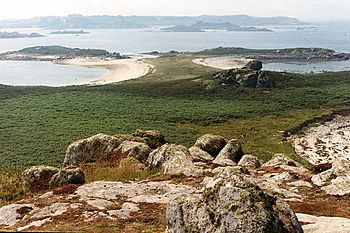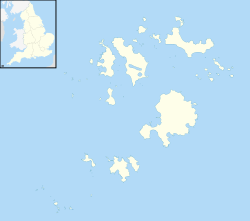Teän facts for kids
|
Enys Tian
|
|
|---|---|

Teän, view from the Great Hill
|
|
| Geography | |
| Coordinates | 49°58′05″N 6°18′44″W / 49.9680°N 6.3123°W |
| OS grid reference | SV908164 |
| Archipelago | Isles of Scilly |
| Area | 0.062 sq mi (0.16 km2) |
| Administration | |
|
United Kingdom
|
|
| Civil parish | Tresco |
| Demographics | |
| Population | 0 |
Teän (pronounced TEE-ən) is an island in the Isles of Scilly. It's located north of the main islands. You can find it between Tresco (about 1.5 km to the west) and St Martin's (about 300 m to the east). No one lives on Teän today.
The island is about 16 hectares (or 0.062 square miles) in size. It has several large granite rock formations called tors. The highest point is Great Hill, which rises to 40 meters (about 130 feet) on the eastern side. The lower areas of the island are covered with soil and gravel left behind by ancient glaciers. You can even see large rocks, called glacial erratics, on the northern beaches. These rocks show how far the ice sheets once reached. Because of this, Teän is a special place for studying geology.
People lived on Teän from the Bronze Age (a very long time ago) until the early 1800s. Even in 1945, animals still grazed on the island. There's an old Christian chapel on Teän. It might have been named after a saint called Theon.
Teän is part of the Isles of Scilly Heritage Coast. It's also within the Isles of Scilly Area of Outstanding Natural Beauty. This means it's a very special place with beautiful scenery. The Isles of Scilly Wildlife Trust helps manage the island. They have a special agreement to protect its natural features.
Contents
Island History: Teän's Past Residents
The coastline of Teän has many bays and sandy beaches. At low tide, these connect to rocks and stone piles offshore. On the western part of the island, you can see old field boundaries from the Romano-British period. These are visible when the tide is very low.
One of the stone piles, called Old Man, has an ancient structure. It's a Bronze Age entrance grave. There's another entrance grave on Great Hill in the east. Roman-style brooches have been found in a grave on Old Man. Sixteen early Christian graves were discovered under the east wall of St Theona's chapel. The chapel was built later, on top of these graves. There was probably an even older wooden chapel there before.
In 1652, a survey reported that one man lived in a ruined house on the island. By 1684, there was a small cottage between East Porth and West Porth. It belonged to a Mr. Nance. He is thought to have started "kelp burning" in Scilly. Kelp is a type of seaweed. Burning it creates sodium carbonate, which was used to make glass. This practice continued on the islands until 1835.
Kelp burning only produced a small amount of sodium carbonate. In the 1800s, new industrial ways of making it became popular. This made kelp burning less useful. Families had rights to collect kelp in certain areas. In 1787, some people were accused of taking kelp from Mr. Nance's area. The court decided that Mr. Nance had the right to cut kelp on Teän. The others had to pay a small fine.
Mr. Nance's family lived on Teän for several more generations. By 1717, ten people lived on the island. But in 1752, a visitor named William Borlase only saw fields of corn and ruined buildings. In the 1800s, reports mentioned that people sometimes lived there. A few acres were farmed, and sheep grazed. A guide book from 1919 said it was just a place for rabbits. Cattle were still grazing on Teän in 1945.
Teän's Amazing Wildlife and Plants
Teän was first recognized as a Site of Special Scientific Interest (SSSI) in 1971. This means it's a protected area because of its special plants, animals, or geology. The SSSI was last checked in 2009 and was found to be in good condition. Experts found almost all the expected plants. One plant, the four-leaved allseed, was missing. A key issue was that the orange bird's-foot plant needs short grass to grow well. The Isles of Scilly Wildlife Trust is working to help this plant with their special management plan.
Flora: Plants of Teän Island
People used to live and farm on Teän until recently. About 8 hectares (20 acres) of the island are surrounded by hedges. This area used to be farmed. Here, the soil is deeper, and you'll find lots of bracken. There are also plants that used to grow in pastures, like rye grass, red clover, hop trefoil, and black knapweed.
Along the coast near St Helen's Porth and on the south side, you'll see maritime grassland. This area has many thrift plants and sea campion. Near Clodgie Point, the orange bird's-foot plant grows. The sandy area behind East and West Porth is important for a very rare plant called the dwarf pansy. The top of Great Hill has a small area of lowland heath, which is a type of open land with low-growing shrubs.
Rare Plants You Can Find
- Shore dock (Rumex rupestris): This plant was first seen here in 1984 and was still there in 2005. It's a very important plant for conservation. It's one of the main reasons why the Isles of Scilly is a Special Area of Conservation (SAC).
- Four-leaved allseed (Polycarpon tetraphyllum): This plant was last recorded in 1990.
- Saltwort (Salsola kali): This plant was seen in 2009. It used to be common on most sandy beaches in Scilly but is now rare. The last time it was seen in Scilly before 2009 was in 2004 on Samson.
Fauna: Animals of Teän Island
The only mammals found living on Teän today are the Brown Rat and the House Mouse. Rabbits may no longer be on the island. Without grazing animals like rabbits, plants that need short grass, like the orange bird's-foot, might disappear. In 1850, someone reported that Teän was a "preserve of white rabbits"! Bones of the Scilly Shrew have been found in old rubbish piles from Roman or early medieval times. The shrew was last recorded in 1964, but there are no recent sightings.
Breeding Birds on Teän
The SSSI list mentions five types of birds that breed on Teän. These include the Puffin. Other seabirds that breed here are the Kittiwake, Herring Gull, Lesser Black-backed Gull, and a few Greater Black-backed Gull. Sadly, seabird colonies in the Isles of Scilly are declining. From 2006 to 2009, Kittiwakes almost stopped breeding on all the islands. Only one chick was raised on St Agnes in 2009. None of the seabirds listed above were recorded breeding on Teän in 2009.
However, a pair of Marsh Harriers bred on Teän in 2008. Two young birds were seen.
Invertebrates: Insects and More
Teän was the site of important studies on the Common Blue butterfly. In 1938, scientists E. B. Ford and W. H. Dowdeswell camped on the island. They marked each butterfly with a tiny dot of paint. This helped them track when they first caught a butterfly and if they caught it again. The Common Blue butterfly doesn't migrate far. So, new butterflies on Teän likely hatched there. The scientists noticed that the Common Blue butterflies on Teän were different from those on other islands. This was probably because Teän was isolated.
Ford described the female butterflies on Teän as having more pale, silvery-blue scales. This made them look different from those found elsewhere. Also, many butterflies on Teän had a special mark on the underside of their hind wings. Two spots along the edge were joined, forming a curved line. Ford thought this might be a step in the evolution of a new type of butterfly. However, recent visits haven't found the Common Blue butterflies on Teän to be very different anymore. It seems that unusual butterfly colors and patterns might just happen more often in Scilly.
Red Barbed Ant (Formica rufibarbis) The Red Barbed Ant is considered one of the rarest animals in mainland Britain. There are only four nests in Surrey, and it's no longer found in Cornwall (last seen there in 1907). This ant has been found on St Martin's, the Eastern Isles, and also on Teän in 2008. It likes open heathland with lots of bare ground. Queen ants from St Martin's are sometimes taken to Surrey to help keep those colonies going.
Images for kids



